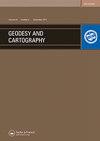Comparing variance of signal contained in the most recent GRACE solutions
IF 2.1
Q3 REMOTE SENSING
引用次数: 5
Abstract
: Gravity Recovery and Climate Experiment (GRACE) mission data is widely used in various fields of science. GRACE explored changes of the gravity field regularly from April 2002 to June 2017. In the following research, we examine variance of signal contained in two different formats of GRACE data: standard spherical harmonics and mass concentration blocks (so-called “mascons”) solutions, both provided in the most recent releases. For spherical harmonics-based solution, we use monthly gravity field solutions provided up to degree and order (d/o) 96 by three different computing centers, i.e. the NASA’s Jet Propulsion Laboratory (JPL), the German Research Center for Geosciences (GFZ) and the Center for Space Research (CSR). For the mass concentration blocks, we use values of total water storage provided by the CSR, JPL and the Goddard Space Flight Center (GSFC) computing centers, which we convert to spherical harmonic coefficients up to d/o 96. We show that using the anisotropic DDK3 filter to smooth the north-south stripes present in total water storage obtained from standard spherical harmonics solution leaves more information than common isotropic Gaussian filter. In the case of mascons, GSFC solution contains much more information than the CSR and JPL releases, relevant for corresponding d/o. Differences in variance of signal arise from different background models as well as various shape and size of mascons used during processing of GRACE observations.比较最新GRACE解中包含的信号方差
本文章由计算机程序翻译,如有差异,请以英文原文为准。
求助全文
约1分钟内获得全文
求助全文
来源期刊

Geodesy and Cartography
REMOTE SENSING-
CiteScore
1.50
自引率
0.00%
发文量
0
审稿时长
15 weeks
期刊介绍:
THE JOURNAL IS DESIGNED FOR PUBLISHING PAPERS CONCERNING THE FOLLOWING FIELDS OF RESEARCH: •study, establishment and improvement of the geodesy and mapping technologies, •establishing and improving the geodetic networks, •theoretical and practical principles of developing standards for geodetic measurements, •mathematical treatment of the geodetic and photogrammetric measurements, •controlling and application of the permanent GPS stations, •study and measurements of Earth’s figure and parameters of the gravity field, •study and development the geoid models,
 求助内容:
求助内容: 应助结果提醒方式:
应助结果提醒方式:


